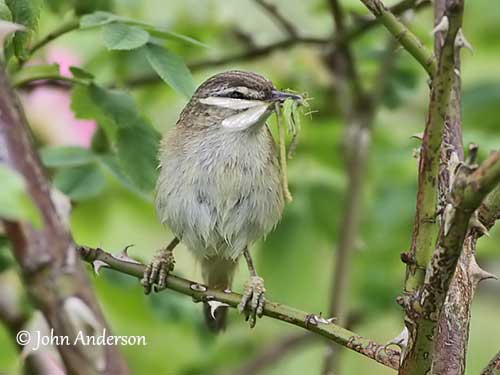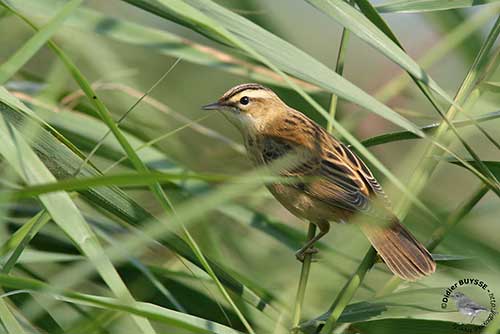
Fr: Phragmite des joncs
Ang: Sedge Warbler
All: Schilfrohrsänger
Esp: Carricerín Común
Ita: Forapaglie comune
Nd: Rietzanger
Sd: sävsångare
Photographers:
John Anderson
John Anderson Photo Galleries
José Luis Beamonte
Pájaros de España
Didier Buysse
Vision d’Oiseaux
Steve Garvie
RAINBIRDER Photo galleries & Flickr Rainbirder
Otto Plantema
Trips around the world
William Price
PBase-tereksandpiper & Flickr William Price
Nicole Bouglouan
Photographic ramble & My pictures on IBC
Text by Nicole Bouglouan
Sources:
HANDBOOK OF THE BIRDS OF THE WORLD Vol 11 by Josep del Hoyo, Andrew Elliott and David Christie - Lynx Edicions - ISBN: 849655306X
THE COMPLETE BOOK OF BRITISH BIRDS – Written by “Royal Society for the Protection of Birds” experts - Préface de Magnus Magnusson - Michael Cady- Rob Hume Editors - ISBN: 0749509112
THE HANDBOOK OF BIRD IDENTIFICATION FOR EUROPE AND THE WESTERN PALEARCTIC by Mark Beaman, Steve Madge - C. Helm - ISBN: 0713639601
ENCYCLOPEDIE DES OISEAUX DE FRANCE ET D’EUROPE – de Peter Hayman et Rob Hume - Flammarion – ISBN : 2082009920
BIRDS OF AFRICA SOUTH OF THE SAHARA by Ian Sinclair and Peter Ryan - Princeton University Press Princeton and Oxford - ISBN: 0691118159
BIRDS OF THE MIDDLE EAST by R.F. Porter, S. Christensen, P Schiermacker-Ansen C.Helm - ISBN: 0713670169
Wikipedia, the free encyclopaedia
What Bird-The ultimate Bird Guide (Mitchell Waite)
Pájaros de España (JL Beamonte)
Birds of Britain - The Web Magazine for Birdwatchers
SORA Searchable Ornithological Research Archive (Blair O. Wolf)
Sedge Warbler migration and reed aphids
Sedge Warbler
Acrocephalus schoenobaenus
Passeriformes Order – Acrocephalidae Family
INTRODUCTION:
The Sedge Warbler is an Old World warbler, a medium-sized, plump passerine with conspicuous pale supercilium.
It breeds in Europe, E to W Siberia, and winters in sub-Saharan Africa. This small bird travels an unbelievable distance of about 3800 kilometres to reach its wintering areas, flying straight across Sahara and Mediterranean Sea.
The Sedge Warbler frequents a variety of damp habitats, but it also occurs away from water in hedgerows or tall crops. It may sing night and day on the breeding grounds, while searching for a mate and defending a territory.
The Sedge Warbler is widespread throughout its wide range, but this species is vulnerable to severe droughts in Africa, often involving decline of the population. But currently, it is not globally threatened.

DESCRIPTION OF THE BIRD:
Biometrics:
Length: 12-13 cm
Wingspan: 19 cm
Weight: 12 gr
The Sedge Warbler adult has brown and buff plumage, with olive brown mantle and scapulars with darker streaks. The rump is mostly cinnamon and unstreaked. On the upperwing, the flight feathers are brown with pale buff edges. The wing-coverts are blackish-brown with pale edges. The round-cornered tail is dark brown.
On the underparts, chin, throat and belly are white. Rest of underparts is mostly creamy to buffy-white, and flanks are rusty buff. On the underwing, axillaries and coverts are whitish with dark centres.
On the head, the crown is dark and finely streaked. We can see a conspicuous buffy-white supercilium, extending from the upper base of the bill to the rear end of the ear-coverts where it is broader. Lores are dark, contrasting with yellowish-brown cheeks and ear-coverts.
The two-tone bill has blackish-brown upper mandible, and yellowish to pinkish base of lower mandible. The eyes are dark brown. Legs and feet are brownish-grey.
Male and female are similar.
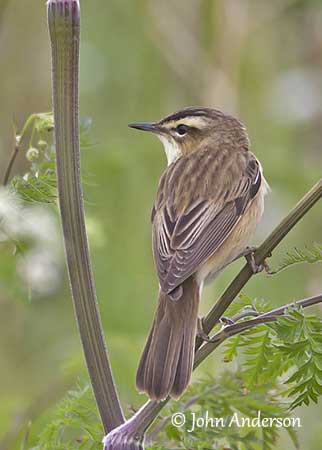
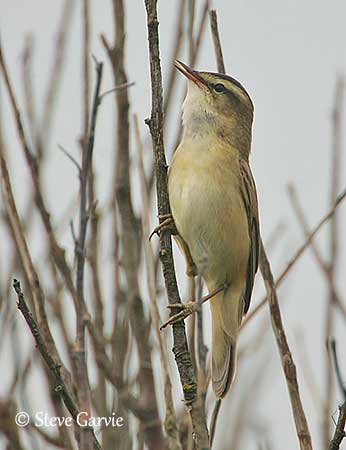
The juvenile has yellower and buffer plumage than adults, but the pattern is similar. On the head, it has a buffy-brown central crown stripe, and the breast is slightly spotted or speckled.
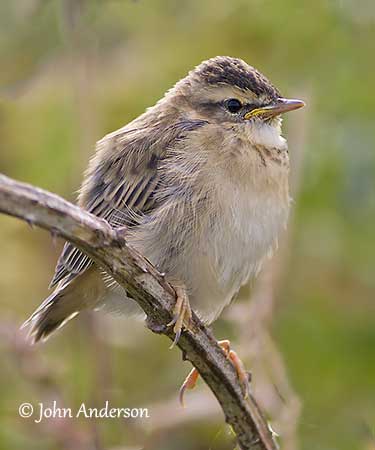
RANGE:
The Sedge Warbler breeds in Europe (except S and SW), as far as N Scandinavia, E to W Siberia, E to R Yenisey, Turkey, Caucasus and N Kazakhstan. It winters in sub-Saharan Africa. The species is vagrant in Seychelles and Spitsbergen.
HABITAT:
The Sedge Warbler breeds mainly in lowlands and valleys, and frequents a great variety of cool, moist habitats. The nest is often near water, in the drier edges of reedbeds to sedge marshes, or in stands of moist, tall grassy areas and tangled thickets. However, it breeds locally in drier habitats and away from water, in tall crops, hedgerows or low bushes. It is visible from sea-level up to 1900 metres of elevation. It usually avoids trees, tall bushes and open areas.
During winter in Africa, it can be found in reedbeds, wet grassland, bushes, marshy habitats in lowland rainforest and low trees close to water. On passage, it frequents drier bush and thicket, and occasionally desert scrub.
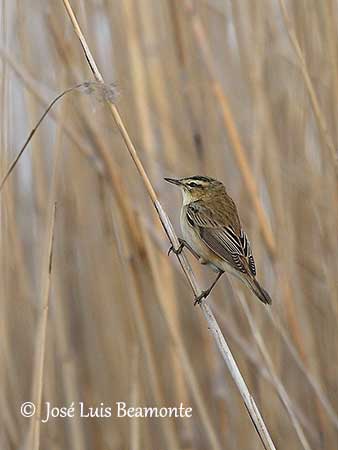
CALLS AND SONGS: SOUNDS BY XENO-CANTO
The Sedge Warbler’s typical call is a scolding “tuk”, sometimes repeated into “tuk-tuk-tuk-tutututuktuk” when the bird is excited. It also utters a harsh, grating “chek” and a fast, churring “trrr”.
The song is a harsh chattering interspersed with sharp, melodious phrases. Other sounds include scratches of mimicry and grating sounds, given from perch or in flight. This species sings by night and by day.
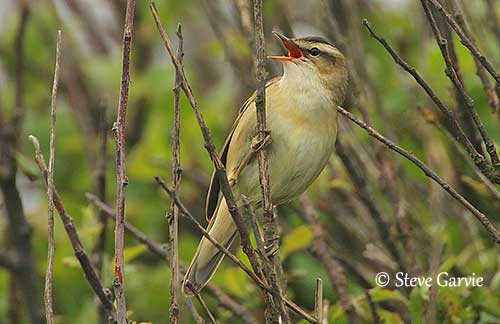
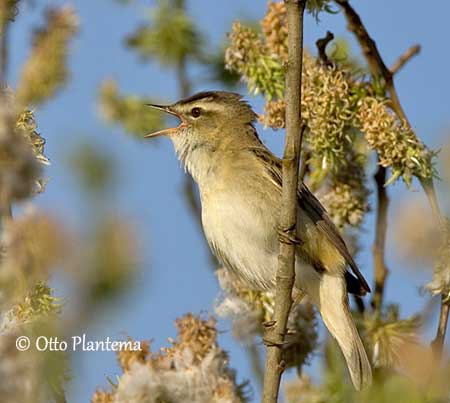
BEHAVIOUR IN THE WILD:
The Sedge Warbler is primarily insectivorous and feeds on insects and their larvae. It also takes spiders, small slugs, snails and earthworms. During autumn and winter, it consumes plant material, usually berries of elderberry and bramble. In Africa, it takes flowers and fruits of Salvadora persica and seeds of sedges.
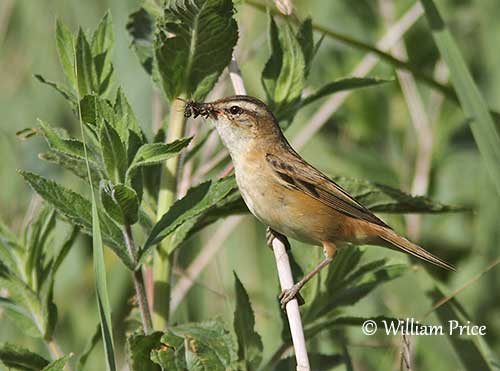
It hunts for prey at dawn and dusk, and forages in low, dense vegetation by picking prey from leaves and twigs. But the larger prey are caught in flight and sometimes from the ground.
It is often very active when foraging, hopping, jumping or hanging head-down to find invertebrates on the underside of the leaves.
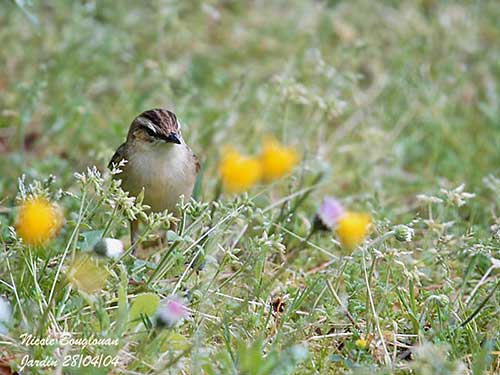
I saw this bird in my yard in April, more than 4 km away from the local lake. It was searching for preys in the grass, close to tall hedgerow of Cherry laurel.
The Sedge Warbler males usually arrive at the breeding grounds two weeks before the females. It selects territories for pairing and nesting. It performs elaborate flight displays. A male starts to sing and takes off from its perch and climbs steeply upwards with rapid wingbeats. Then, the rhythm changes and becomes a deep, slow fluttering. It performs a short circular or straight flight before to descend and land on the same perch or one nearby while stopping its singing.
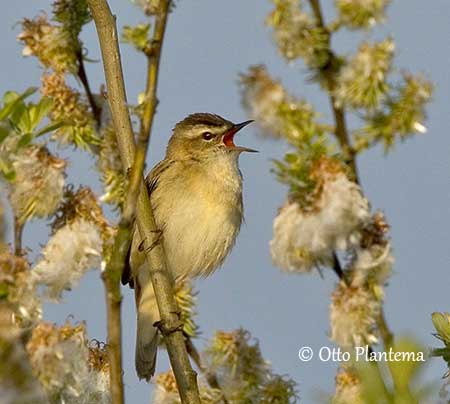
The Sedge Warbler is usually monogamous, with some cases of polygynous individuals. The male is often conspicuous before pairing, but once the pair is formed, it becomes more elusive.
In territorial defence, its song is directed at rivals. The male is known for its complex song, adding phrases into the song and never singing the same tune twice. This feature is used by females to select a mate with large repertoire.
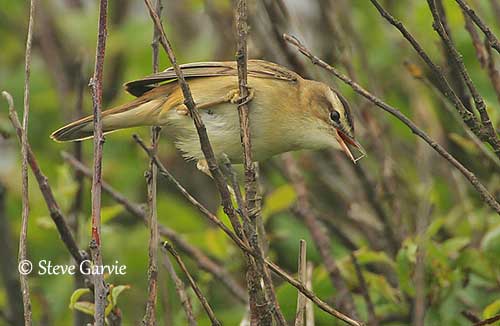
The Sedge Warbler is migratory and often forms small groups during the migration and around abundant food sources. It needs large fat reserves to perform such long migration, and the heaviest birds are able to make unbroken flight. The fat reserves are mainly built by feeding on numerous reed aphids (Hyalopterus pruni).
After breeding, it moves S to sub-Saharan Africa, with main arrivals from mid-September in Zambia, but to November/December farther south. The return migration to N starts in late March/mid-April. They reach the breeding grounds in second half of April in W Europe, in late April/early May in C Europe, and early May in S Finland.
In flight, the Sedge Warbler alternates several rapid wingbeats with short glides.
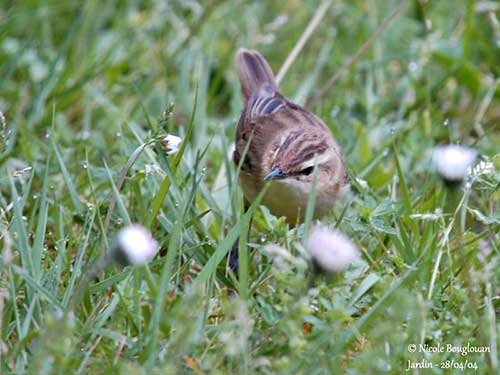
REPRODUCTION OF THIS SPECIES:
The breeding season takes place in spring, with the laying late April and mid-May according to the range.
The Sedge Warbler’s nest is placed between 10 and 70 centimetres above the ground (rarely above water), often in reedbed near water, but also well hidden among the vegetation away from water.
The female builds a deep cup with outer structure of loosely woven grass, stems, leaves, moss and sedges held together with spider webs. It is thickly lined with softer plant material, hair and plant down. The structure is usually supported on vertical stems, with the outer part of the nest woven around.
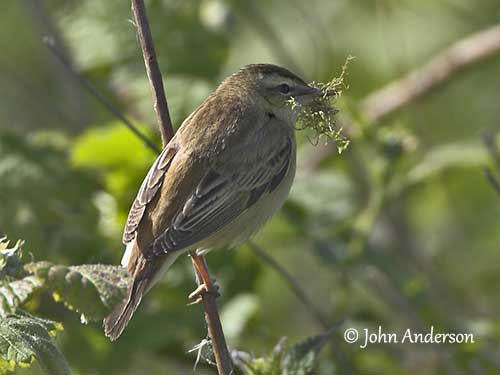
The female lays 5-6 pale green eggs with fine olive mottling overall. She incubates alone during 13-15 days, but the male takes part in nesting duties once the chicks have hatched. The young leave the nest 11-12 days after hatching. They are independent at age of 25-30 days.
PROTECTION / THREATS / STATUS:
The Sedge Warbler is widespread in its wide range, with rapid expansion in Finland in last 100 years, due to habitats changes.
A very preliminary estimate of the global population size is 17,800,000/44,400,000 individuals, but further validation is needed.
The population trend is relatively stable, and the Sedge Warbler is currently evaluated as Least Concern.
